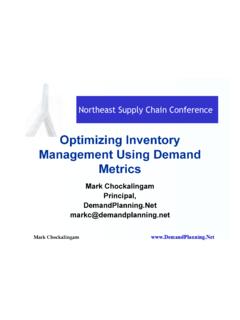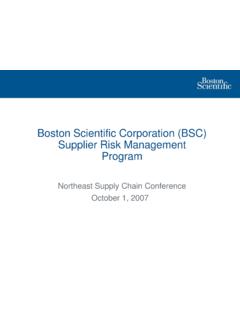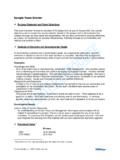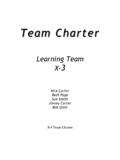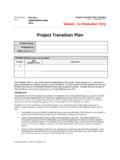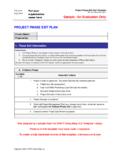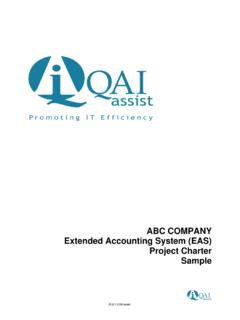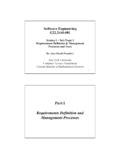Transcription of Key Steps in Implementing a Kaizen Event - …
1 Northeast Supply Chain ConferenceKey Steps in Implementing a Kaizen EventTom McBridePartners for Creative Solutions, Inc.(508) 845-15462 What We Will Cover What are Kaizen events ? Choosing the best projects Selecting a pilot Event Team members and their roles How to prepare for a Kaizen Event 10 Steps for conducting the Event Finding the time for Kaizen events3 About Kaizen Kaizen is continuous improvement Kaizen is employee involvement Kaizen requires a cultural change According to the originators at Toyota 80% of the journey involves learning and living the new philosophy 20% involves physical changes4A Kaizen Event Is a highly focused assault on an area or process to achieve rapid improvement Uses a cross-functional team with process insiders and outsiders Achieves as many improvements as possible during a typical 3-5 day Event Augments, but does not replace.
2 Continuous improvement5 Some Paths to Improvement Individual efforts Part-time groups or teams Kaizen events6 When Are Kaizen events Appropriate? Need for solution is urgent Competitive crisis High customer dissatisfaction Big impact projects Significant impact on sales or profits Bottlenecks Cannot tolerate prolonged disruption 7 Selecting Candidates for Kaizen events Factors to consider Strategic goals of the organization Current performance of process, department, machine (good time for Value Stream Mapping) Feasibility (difficulty, resources required, probability of success) Selecting the top few candidates Decision matrix (sample available on request)8 Value Stream Map Technique to analyze the production of a product line from receiving dock to shipping dock Structured way to gather, organize, and present pertinent data about the existing process9 Value Stream Map12 Production lead time= 521,874 secValue-added time1,674 secWeekly shipments:700,000 lineal50,000 pieces1,034 sec280 secIMolder #4 Crew size: 4 Run speed 300 ft/minOutput:1,285 pieces/hrWaste = 1/2%Sec available27,000C/T= secC/O= 5 - 45 min% Crew:days= 100%swing = 0 %% Reliability = 98%Weekly hr = size: 3 Run speed: 3,15 l ft/minOutput:1,350 pieces/hrWaste = 3%Sec available 27,000C/T= secC/O= 1 min - 1 hr% Crew:days =100%swing =% Reliability =73%Weekly hr = secFrom F/J.
3 Staging5,350 finished pieces/dayILam #1 Crew size: 4 Run speed 58 ft/minOutput: 500 pieces/hrWaste = 1/2%Sec available 27,000C/T= secC/O= 5 - 25 min% Crew:days= 100%swing = 0%% Reliability = 98%Weekly hr = 55 %90 %IResaw (4 saws)Crew size: 1 1/3 Run speed 184 :1,584 pieces/hrWaste =Sec available 108,000C/T= secC/O= 7 - 30 min% Crew Days =100%Swing =0%% Reliability = 95%Weekly hr = %10%230 sec90%268 pieces4,500 pieces9000pcs9, hr48 hr48 hr48 hrVA Ratio 1:3116-day lead time as shownValue Stream Map - Current State10 Selecting the Pilot Event High likelihood of success Results will be highly visible Makes a significant impact to the organization Solves operational problems, not management issues Area has a stable current process11 Preparing For the Event Select team sponsor Select team leader Choose the facilitator Choose team participants Develop the team charter Gather data prior to the Event Prepare the organization12 Team Sponsor High level championof the cause Upper management advisorto the team Breaks through road blocks Arranges support for the team during the Event Ensures coverageso that team members are not interrupted during the event13 Team Leader Determines session objectives and process to be followed Meets with facilitator to review session objectives and process Sends agenda to team members in advance Is the leader.
4 Not the boss14 Traits of Good Team Leaders Previous success as a leader (church, scouts, military, civic, etc.) Has experienced a Kaizen Event Good knowledge of lean manufacturing (if production area Event ) Good knowledge of waste elimination techniques Not dictatorial - understands participative management Comfortable working in the target area Good people skills15 Team Facilitator Manages how people work together during team activities Keeps activities moving along the process and time schedule set by the team leader16 Recorder Records important results, actions, & decisions Promptly distributes minutes to participants Usually a team member17 Identify Other Members Insiders who work in or around the process Machine Operator Buyer Assembler Planner Outsiders Provides non-tainted viewpoint & new ideas Can be inside or outside of the company18 Traits of Good Participants Understands the target area May work in area Can learn the area Open to doing things differently Will get involved Good communicators Brings knowledge (technical or procedural) that will help the team succeed19 The Kaizen Team Charter Team Charter clearly identifies rules of operation Objectives Scope Resources available (budget, assistance, etc.)
5 Authority of the team (and it s limits) Deliverables Schedule Code of Conduct (developed at kick-off meeting) Created by leader and approved by team20 Before 1stTeam Meeting Gather detailed information in advance Process Steps WIP levels Capacities/process times What is produced and how much? Cycle and queue times Batch sizes & changeover frequency Defect Rates Up-time Number of operators Photos and layout of target area21 Rolling Out the Kaizen Event Preparing the Organization - considerations Developing a sense of trust across the organization Generating enthusiasm about the Event Demonstration of commitment by management Publicizing the Event - before and after Getting the union to cooperate Team Kickoff (includes sponsors) Review draft charter, modify, approve Develop code of conduct (agreement on rules) Discuss training and Event logistics, the Proper Environment for the Event Logistics Location off-site, on-site, or in work area Food feed the team feed everyone?
6 Tools, supplies Work hours (in advance) Handling interruptions (coverage) Support from rest of organization (sponsor s responsibility) Energy breaks23 Kaizen Event Sequence(Start to Finish)Creates a Plan That has Team Buy-in1. Training & kick-off activitiesA. Lean manufacturing (if in production area)B. Tools of continuous improvement(pareto, fishbone, run charts, 5-whys, process analysis, etc.)2. Analysis of current state 3. Select areas of focus4. Create possible solutions5. Select solutions24 Useful Tool -ParetoAnalysis Helps visualize the larger sources of waste Visual application of the 80-20 rule Helps team focus on those causes that have the greatest impact if solved050100150# of strokesGolf Score Pareto Chartputtschipsapproachesdrivesfairwayst otal25 Analyzing the Current State-Some Wastesto Look For Too many process Steps Excessive travel distance or time Waiting Ineffective scheduling Excessive handling Inventory storage areas Excess WIP26 Analyzing the Current State-Some Wastesto Look For Bottlenecks Defects Poor organization of work area (5S needed) Large batch sizes and long setup times Disjointed process Steps (need flow)
7 Inefficient processes Opportunities to apply technology to improve efficiency27 Creating Solutions Open your mind to new possibilities Don t be bound by what is done today Do you need it? Should it be outsourced? Build it a different way Design it differently Don t be discouraged by prior failures We tried to get approval for that before! That ll never happen!28 Visualizethe Perfect Solution What would be the idealsituation? What if allwaste were eliminated? Elevates the target for generating solutions29 Kaizen Event SequenceGets the job done6. Establish metrics for success7. Plan & implement (repeat if necessary)8. Standardize and sustainPaves the way for future events9. Report results10. Celebrate30 Finding Time for Kaizen events Work overtime to recover lost production Reroute production to other area Perform the Event over a weekend Run the Event early in a production period Finish period production early and then run the Event Take advantage of a slow time Outsource some production to buy time Run the Event concurrent with production31 Successful Uses of the Process Sales - quotes take too long Reduced quote cycle by >40% Improved on-time delivery of quotes from ?
8 To >80 % Engineering a bottleneck Improved on-time releases of engineering from <<50% to >80% Assembly high cost 40 % reduction in manual assembly costs32 Successful Uses of the Process Quality costs too high 50% reduction in defects Late material deliveries Late deliveries cut in half33 Summary What are Kaizen events ? Choosing the best projects Selecting a pilot Event Team members and their roles How to prepare for a Kaizen Event 10 Steps for conducting the Event Finding the time for Kaizen events

